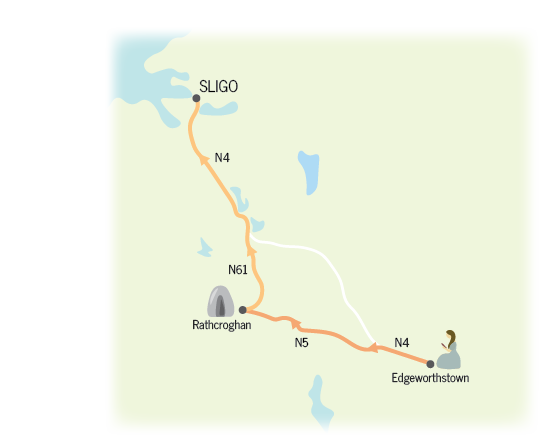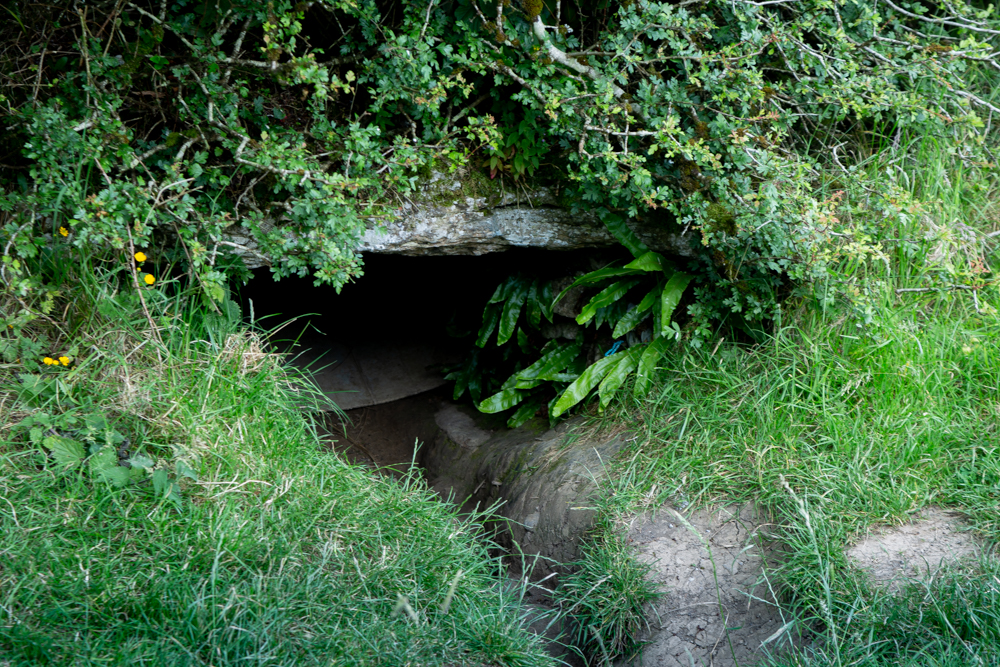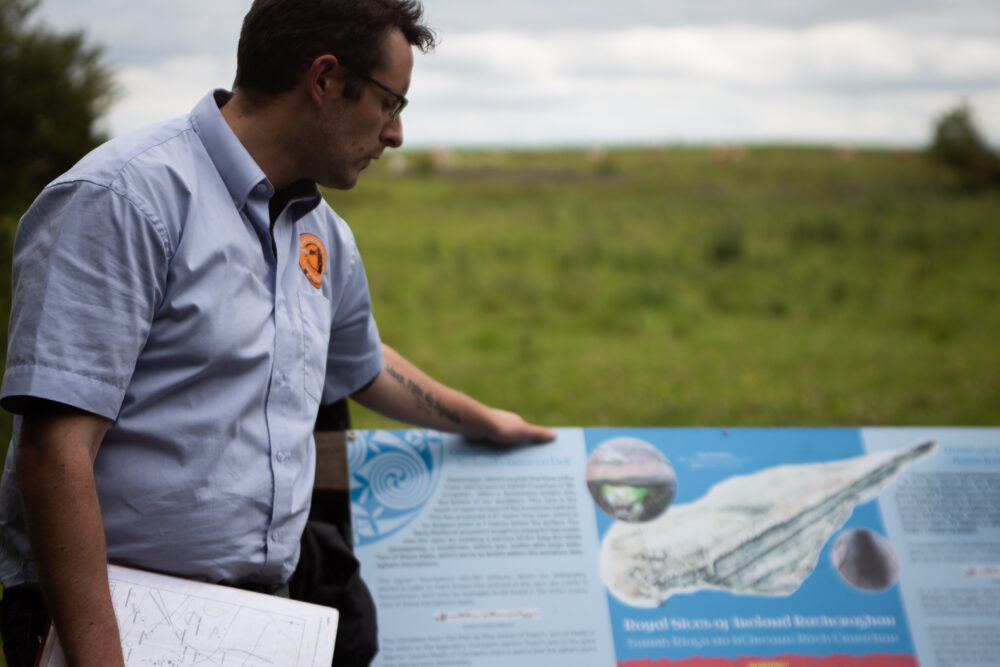Day One: Rathcroghan and Queen Meadhbh
Our next stop is Rathcroghan in Co. Roscommon, which the guide describes as the site of a “prehistoric Longitude festival”. Tours have to be booked in advance, so of course we call from the car as we leave Dublin. There are three places left. Tours start at 2pm daily, we call at 12, the journey takes an hour and 45 minutes. Be grand.

We meet at the visitor centre, which is worth a wander round so aim to arrive in plenty of time before the tour (unlike us) as by the time you get back it may be closed. Our guide Daniel ushers us all into a minibus and we head off to the site. A word of warning: if you’re going to Rathcroghan be prepared to get mucky. It will be worth it.
Daniel is a storyteller in the Irish tradition, weaving his knowledge of archaeology, prehistory and mythology to engage us in the story of Queen Meadhbh (variants Maedhbha, Maeve, Meabh or Medb, because Irish) and the megalithic monuments associated with her. If you’re at all familiar with An Táin you’ll know the story of the white bull of Cooley (Rathcroghan is part of the Táin trail). Meadhbh was married to Ailill – a marriage of equals in Brehon Law. This is significant; a recurring theme in Irish epic storytelling is that there is balance and equality and then something upsets that balance. In Meadhbh’s case her wealth is equal to that of her husband apart from one brown bull. She hears tell of a legendary white bull on the Peninsula of Cooley and strikes a bargain with the King of Ulster to purchase it, the offer including “her friendly thighs”.
a recurring theme in Irish epic storytelling is that there is balance and equality and then something upsets that balance
But things don’t go exactly to plan. After the deal is done her soldiers are overheard boasting by the king, who reneges on the bargain as a result. War ensues. (Lads, lads did you never hear the saying Make Love Not War?) There is a slight issue for the men of Ulster, who are unable to fight as they’d been previously cursed by Macha, the goddess of Ulster (we won’t go into her story here but suffice to say, they deserved it). At their hour of greatest need they are stricken with birthing pangs. Cúchulainn saves the day on the technicality that he is not quite yet a man.

But was Meadhbh a Queen or a goddess? She is reputed to have had seven lovers, her husband and one lined up in his shadow. She’s the constant, her ‘kings’ are temporary. And this is where mythology meets prehistory. When a king was crowned in Ireland, it was understood that he was marrying the mother / earth goddess and his job was to keep her happy. It’s known that sucking on the king’s nipples was an act of supplication, as he was a conduit to the mother goddess. And if she wasn’t happy? Crops failed and kings were deposed. Evidence from bog bodies, which were previously understood to have been murdered while travelling through the bog, suggest that actually they were people of high status and were deliberately placed in the bog to prevent them from decomposing and returning to the earth (goddess) – no greater punishment. Some of these bodies have been found to have been ritually de-nippled. (There may be a lesson here for contemporary leaders in an age of runaway climate change and governmental indifference. Mother earth is definitely not happy. Time for some de-nippling).
Emerging into the light through the narrow mouth of the cave is a powerful experience
So far so fascinating but the highlight of the tour was yet to come. We hopped into the minibus again for a short trip to Oweynagat, alternatively known as the birthplace of Queen Meadhbh or, if you are of a Christian persuasion, the gateway to hell. Oweynagat is a souterrain or small cave which may or may not be the entrance to the underworld. There are many stories about it – it’s where the sun disappeared in winter when the Morrigan came to destroy the earth. Or it’s the route to Tir na nÓg (where time moves slower), which may have its origins in the use of souterrains for food conservation. If the food above ground spoiled and the food in the souterrain was still fresh, time was different in there. It may have been where young warriors were ritually sent to face their fears and emerge as men. It’s definitely mucky, slippy, claustrophobic and dark, with treacherously sharp rocky bits. But if you want to immerse yourself in a liminal space and be rebirthed through a limestone vagina, it has to be done.
Emerging into the light through the narrow mouth of the cave is a powerful experience. Whatever you believe, a site of Pagan ritual for so many centuries retains an energy impossible to put into words, but we all felt it. Over the cave hangs a hawthorn (our first of many), otherwise known in Ireland as the fairy tree, and judging by the offerings left on its branches, it is still a place of ritual. Compared to other prehistoric sites like Brú na Bóinne, Rathcroghan has ridiculously few visitors. We want to tell people about it (and Daniel requested a TripAdvisor review) because it deserves to be experienced, but we also want to keep it quiet so it doesn’t lose its magic.
Bibliography
Rathcroghan Visitor Centre – Where History Comes To Life
The curse of Macha. VisitUlster.com
The Táin: translated from the Old Irish epic An Táin Bó Cúailnge by Ciaran Carson (2008). Penguin.

